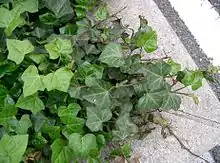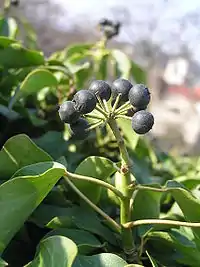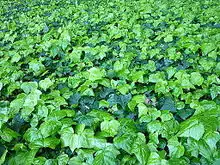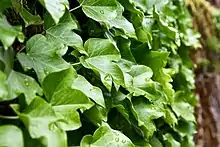Hedera helix
Hedera helix, the common ivy, English ivy, European ivy, or just ivy, is a species of flowering plant in the family Araliaceae, native to most of Europe and western Asia. A rampant, clinging evergreen vine, it is a familiar sight in gardens, waste spaces, on walls, tree trunks and in wild areas across its native habitat. As a result of its hardy nature, and its tendency to grow readily without human assistance, English ivy has attained popularity as an ornamental plant, and escaped plants have led to naturalisations outside its native range.
| Hedera helix | |
|---|---|
 | |
| Creeping on roadside | |
| Scientific classification | |
| Kingdom: | Plantae |
| Clade: | Tracheophytes |
| Clade: | Angiosperms |
| Clade: | Eudicots |
| Clade: | Asterids |
| Order: | Apiales |
| Family: | Araliaceae |
| Genus: | Hedera |
| Species: | H. helix |
| Binomial name | |
| Hedera helix | |
Etymology
The genus name Hedera is the Classical Latin word for ivy, which is cognate with Greek χανδάνω (khandánō) "to get, grasp", both deriving ultimately from Proto-Indo-European *gʰed- "to seize, grasp, take". The specific epithet helix derives from Ancient Greek ἕλιξ (elix) "helix" and from the Latin helicem, "spiral" first used around 1600.The binomial in its entirety thus has the meaning "the clinging plant that coils in spirals (helices)".[1][2] [3] The modern English ivy derives from Middle English ivi from Old English īfiġ, deriving in turn from Proto-Germanic *ibahs. The meaning is uncertain but the word may be cognate with the Ancient Greek ἴφυον (íphuon) meaning, not Hedera helix, but the (unrelated) Lavandula spica.[4]
Synonyms
Synonyms include Hedera acuta, Hedera arborea ("tree ivy"),[5] Hedera baccifera, Hedera grandifolia,[6] bindwood, and lovestone.
Description


Hedera helix is an evergreen climbing plant, growing to 20–30 m (66–98 ft) high where suitable surfaces (trees, cliffs, walls) are available, and also growing as groundcover where no vertical surfaces occur. It climbs by means of aerial rootlets with matted pads which cling strongly to the substrate. The ability to climb on surfaces varies with the plants variety and other factors: Hedera helix prefers non-reflective, darker and rough surfaces with near-neutral pH. It generally thrives in a wide range of soil pH with 6.5 being ideal, prefers moist, shady locations and avoids exposure to direct sunlight, the latter promoting drying out in winter.[7]
The leaves are alternate, 50–100 mm (2–4 in) long, with a 15–20 mm (0.6–0.8 in) petiole; they are of two types, with palmately five-lobed juvenile leaves on creeping and climbing stems, and unlobed cordate adult leaves on fertile flowering stems exposed to full sun, usually high in the crowns of trees or the top of rock faces.
The flowers are produced from late summer until late autumn, individually small, in 3-to-5 cm-diameter (1.2-to-2.0 in) umbels, greenish-yellow, and very rich in nectar, an important late autumn food source for bees and other insects.
The fruit are purple-black to orange-yellow berries 6–8 mm (0.2–0.3 in) in diameter, ripening in late winter,[8] and are an important food for many birds, though somewhat poisonous to humans.
One to five seeds are in each berry, which are dispersed after being eaten by birds.[9][10][11]
Subspecies
The three subspecies are:[9][12]
- H. h. helix - central, northern and western Europe, plants without rhizomes, purple-black ripe fruit,
- H. h. poetarum Nyman (syn. Hedera chrysocarpa Walsh) - southeast Europe and southwest Asia (Italy, Balkans, Turkey), plants without rhizomes, orange-yellow ripe fruit,
- H. h. rhizomatifera McAllister - southeast Spain, plants rhizomatous, purple-black ripe fruit.
The closely related species Hedera canariensis and Hedera hibernica are also often treated as subspecies of H. helix,[11][13] though they differ in chromosome number so do not hybridise readily.[10] H. helix can be best distinguished by the shape and colour of its leaf trichomes, usually smaller and slightly more deeply lobed leaves and somewhat less vigorous growth, though identification is often not easy.[11][14]
Range

It ranges from Ireland northeast to southern Scandinavia, south to Portugal, and east to Ukraine and Iran and northern Turkey.
The northern and eastern limits are at about the −2 °C (28 °F) winter isotherm, while to the west and southwest, it is replaced by other species of ivy.[9][10][11][12][13][15] Hedera helix itself is much more winter-hardy and survives temperatures of −23.3 °C (−9.9 °F) (USDA Zone 6a) and above.[16]
Cultivation and uses

.jpg.webp)
Ivy is widely cultivated as an ornamental plant. Within its native range, the species is greatly valued for attracting wildlife. The flowers are visited by over 70 species of nectar-feeding insects, and the berries eaten by at least 16 species of birds. The foliage provides dense evergreen shelter, and is also browsed by deer.[9][17]
In Europe, it is frequently planted to cover walls[18] and the Bavarian government recommends growing it on buildings for its ability to cool the interior in summer, while providing insulation in winter, as well as protecting the covered building from soil moisture, temperature fluctuations and direct exposure to heavy weather.[19] Further uses include weed suppression in plantings, beautifying unsightly facades and providing additional green by growing on tree trunks.
However, ivy can be problematic. It is a fast-growing, self-clinging climber that is capable of causing damage to brickwork, guttering, etc., and hiding potentially serious structural faults, as well as harbouring unwelcome pests. Careful planning and placement are essential.[20]
Cultivars
Over 30 cultivars have been selected for such traits as yellow, white, variegated (e.g., 'Glacier'), and/or deeply lobed leaves (e.g. 'Sagittifolia'), purple stems, and slow, dwarfed growth.[21]
The following cultivars have gained the Royal Horticultural Society's Award of Garden Merit:[22]
Ethnomedical uses
Ivy extracts are part of current cough medicines.[39] In the past, the leaves and berries were taken orally as an expectorant to treat cough and bronchitis.[40] In 1597, the British herbalist John Gerard recommended water infused with ivy leaves as a wash for sore or watering eyes.[41] The leaves can cause severe contact dermatitis in some people.[42][43] People who have this allergy (strictly a type IV hypersensitivity) are also likely to react to carrots and other members of the Apiaceae as they contain the same allergen, falcarinol.
Invasive species
Like other exotic species, ivy has predominantly been spread to areas by human action. H. helix is labeled as an invasive species in many parts of the United States, and its sale or import is banned in the state of Oregon.[44]
Having disappeared during the glaciation[which?], ivy is believed to have been spread back across the continent by birds once the continent warmed up again.[45] With a great capacity for adaptation, ivy will grow wherever development conditions and habitat similar to that of its European origins exist, occurring as opportunistic species across a wide distribution with close vicariant relatives and few species, indicating recent speciation.
Australia

It is considered a noxious weed across southern, especially south-eastern, Australia and local councils provide free information and limited services for removal. In some councils it is illegal to sell the plant. It is a weed in the Australian state of Victoria.[46]
New Zealand
H. helix has been listed as an "environmental weed" by the Department of Conservation since 1990.[47]
United States
In the United States, H. helix is considered weedy or invasive in a number of regions and is on the official noxious weed lists in Oregon and Washington.[48] Like other invasive vines such as kudzu, H. helix can grow to choke out other plants and create "ivy deserts". State- and county-sponsored efforts are encouraging the destruction of ivy in forests of the Pacific Northwest and the Southern United States.[49][50] Its sale or import is banned in Oregon.[51] Ivy can easily escape from cultivated gardens and invade nearby parks, forests and other natural areas.
British Columbia
Although popular as a winter holiday decoration, H. helix is invasive and is a pathogen alternate host in British Columbia.[52][53]
Control and eradication
Ivy should not be planted or encouraged in areas where it is invasive. Where it is established, it is very difficult to control or eradicate. In the absence of active and ongoing measures to control its growth, it tends to crowd out all other plants, including shrubs and trees.
Damage to trees
Ivy can climb into the canopy of young or small trees in such density that the trees fall over from the weight,[50] a problem that does not normally occur in its native range.[9] In its mature form, dense ivy can destroy habitat for native wildlife and creates large sections of solid ivy where no other plants can develop.[50]
Use as building facade green
As with any self-climbing facade green, some care is required to make best use of the positive effects: Ivy covering the walls of an old building is a familiar and often attractive sight. It has insulating as well as weather protection benefits, dries the soil and prevents wet walls, but can be problematic if not managed correctly.
Ivy, and especially European ivy (H. helix) grows vigorously and clings by means of fibrous roots, which develop along the entire length of the stems. These are difficult to remove, leaving an unsightly "footprint" on walls, and possibly resulting in expensive resurfacing work. Additionally, ivy can quickly invade gutters and roofspaces, lifting tiles and causing blockages. It also harbors mice and other creatures. The plants have to be cut off at the base, and the stumps dug out or killed to prevent regrowth.[54]
Therefore, if a green facade is desired, this decision has to be made consciously, since later removal would be tedious.

Mechanism of attachment
Hedera helix is able to climb relatively smooth vertical surfaces, creating a strong, long lasting adhesion with a force of around 300 nN.[55] This is accomplished through a complex method of attachment starting as adventitious roots growing along the stem make contact with the surface and extend root hairs that range from 20 to 400 μm in length. These tiny hairs grow into any small crevices available, secrete glue-like nanoparticles, and lignify. As they dry out, the hairs shrink and curl, effectively pulling the root closer to the surface.[56] The glue-like substance is a nano composite adhesive that consists of uniform spherical nanoparticles 50-80 nm in diameter in a liquid polymer matrix. Chemical analyses of the nanoparticles detected only trace amounts of metals, once thought to be responsible for their high strength, indicating that they are largely organic. Recent work has shown that the nanoparticles are likely composed in large part of arabinogalactan proteins (AGPs), which exist in other plant adhesives as well.[57][58] The matrix portion of the composite is made of pectic polysaccharides. Calcium ions present in the matrix induce interactions between carboxyl groups of these components, causing a cross linking that hardens the adhesive.[57]
References
- Harrison, Lorraine (2012). RHS Latin for gardeners. United Kingdom: Mitchell Beazley. p. 224. ISBN 978-1-84533-731-5.
- "Helical (Helix)". Online Etymology Dictionary, Douglas Harper. 2018. Retrieved 15 November 2018.
- https://en.wiktionary.org/wiki/hedera#Latin
- https://en.wiktionary.org/wiki/ivy
- Bean, W. J. (1978) Trees and Shrubs Hardy in the British Isles Volume 2.
- International Plant Names Index
- "Plants & Flowers—Hedera helix Jubilee". Retrieved 2015-08-20.
- RHS A-Z encyclopedia of garden plants. United Kingdom: Dorling Kindersley. 2008. p. 1136. ISBN 978-1-4053-3296-5.
- Metcalfe, D. J. (2005). "Biological Flora of the British Isles no. 268 Hedera helix L" (PDF). Journal of Ecology. 93 (3): 632–648. doi:10.1111/j.1365-2745.2005.01021.x.
- McAllister, H (1982). "New work on ivies". Int. Dendrol. Soc. Yearbook. 1981: 106–109.
- Flora of NW Europe
- Ackerfield, J. & Wen, J. (2002). A morphometric analysis of Hedera L. (the ivy genus, Araliaceae) and its taxonomic implications. Archived 2011-08-08 at the Wayback Machine Adansonia sér. 3, 24 (2): 197-212.
- Flora Europaea: Hedera helix
- The Holly and the Ivy. Shropshire Botanical Society Newsletter Autumn 2000: page 14
- Stace, C. A. & Thompson, H. (1997). New Flora of the British Isles. Cambridge University Press ISBN 0-521-58935-5
- "Beliebte immergrüne winterharte Kletterpflanzen" (in German). 2013-10-10. Retrieved 2015-08-20.
- Plant for Wildlife: Common Ivy (Hedera helix) Archived 2011-10-06 at the Wayback Machine
- "Efeu Hedera - ein Alleskönner" (in German). Retrieved 2015-08-20.
- "Bauwerksbegrünung - Hinweise zum Energiesparen" (PDF) (in German). Bayerisches Staatsministerium für Wirtschaft und Medien, Energie und Technologie. September 2014. Archived from the original (PDF) on 2015-08-20. Retrieved 2015-08-20.
- "Ivy on buildings". Royal Horticultural Society. Retrieved 5 March 2018.
- NCCPG Plant Heritage: The common ivy
- "AGM Plants - Ornamental" (PDF). Royal Horticultural Society. July 2017. p. 45. Retrieved 3 March 2018.
- "RHS Plant Selector - Hedera hibernica 'Angularis aurea'". Retrieved 5 July 2020.
- "RHS Plantfinder - Hedera helix 'Buttercup'". Retrieved 2 March 2018.
- "RHS Plant Selector - Hedera helix 'Caecilia'". Retrieved 5 July 2020.
- "RHS Plantfinder - Hedera helix 'Ceridwen'". Retrieved 2 March 2018.
- "RHS Plant Selector - Hedera helix 'Congesta'". Retrieved 30 July 2020.
- "RHS Plant Selector - Hedera helix 'Duckfoot'". Retrieved 30 July 2020.
- "RHS Plant Selector - Hedera helix 'Glacier'". Retrieved 5 July 2020.
- "RHS Plant Selector - Hedera helix 'Goldchild'". Retrieved 30 July 2020.
- "RHS Plantfinder - Hedera helix 'Golden Ingot'". Retrieved 2 March 2018.
- "Hedera helix 'Maple Leaf'". RHS. Retrieved 30 July 2020.
- "RHS Plant Selector - Hedera helix 'Manda's Crested'". Retrieved 30 July 2020.
- "RHS Plant Selector - Hedera helix 'Midas Touch'". Retrieved 30 July 2020.
- "RHS Plant Selector - Hedera helix 'Parsley Crested'". Retrieved 30 July 2020.
- "RHS Plantfinder - Hedera helix 'Shamrock'". Retrieved 2 March 2018.
- "RHS Plant Selector - Hedera helix 'Spetchley'". Retrieved 30 July 2020.
- "Hedera helix 'White Knight'". RHS. Retrieved 30 July 2020.
- "BRONCHOSTAD© Hustenlöser-Tropfen - STADA" (in German). Retrieved 2015-08-20.
- Bown. D. (1995). Encyclopaedia of Herbs and their Uses. Dorling Kindersley, London. ISBN 0-7513-0203-1
- Gerard, John (1985). Woodward, Marcus (ed.). Gerard's Herbal: The History of Plants. New York: Crescent Books. ISBN 978-0-517-46470-0.
- Jøhnke, H; Bjarnason, B (1994). "Contact dermatitis allergy to common ivy (Hedera helix L.)". Ugeskr. Laeger. 156 (25): 3778–3779. PMID 8059459.
- Boyle, J.; Harman, R. M. H. (2006). "Contact dermatitis to Hedera helix (Common Ivy)". Contact Dermatitis. 12 (2): 111–112. doi:10.1111/j.1600-0536.1985.tb01067.x. PMID 3987251. S2CID 29719245.
- Oregon bans sale of English ivy, butterfly bushes
- University of Georgia - Center for Invasive Species and Ecosystem Health. "English ivy, Hedera helix (Apiales: Araliaceae)". invasive.org.
- "English Ivy (Hedera helix)". The State of Victoria. Retrieved 17 September 2010.
- Howell, Clayson (May 2008). Consolidated list of environmental weeds in New Zealand (PDF). DRDS292. Wellington: Department of Conservation. ISBN 978-0-478-14413-0. Archived from the original (PDF) on 2009-05-30. Retrieved 2009-05-06.
- USDA Plants Profile: Hedera helix
- "Ivy chasers in a league of their own". Pamplin Media Group. Archived from the original on 2011-06-08. Retrieved 2008-11-27.
- Controlling English Ivy Arlington County, Virginia Department of Parks, Recreation and Community Resources.
- Controlling English Ivy Archived 2008-12-10 at the Wayback Machine. Northwest Coalition for Alternatives to Pesticides.
- "Ring in the holiday season and reduce the spread of invasive species! -". Invasive Species Council of British Columbia | ISCBC Plants & Animals. 2020-02-10. Retrieved 2020-12-27.
- "English Ivy". Invasive Species Council of British Columbia. 2020-02-10. Retrieved 2020-12-27.
- "Ivy on buildings". Royal Horticultural Society. Retrieved 21 June 2013.
- Xia, Lijin; Lenaghan, Scott C.; Zhang, Mingjun; Wu, Yu; Zhao, Xiaopeng; Burris, Jason N.; Stewart, C. Neal (2011-03-01). "Characterization of English ivy (Hedera helix) adhesion force and imaging using atomic force microscopy". Journal of Nanoparticle Research. 13 (3): 1029–1037. Bibcode:2011JNR....13.1029X. CiteSeerX 10.1.1.495.3698. doi:10.1007/s11051-010-0091-3. ISSN 1388-0764. S2CID 18080100.
- Melzer, Bjorn (September 2010). "The attachment strategy of English Ivy: a complex mechanism acting on several hierarchical levels". The Journal of the Royal Society.
- Huang, Yujian (April 2016). "Nanospherical arabinogalactan proteins are a key component of the high-strength adhesive secreted by English ivy". Proceedings of the National Academy of Sciences of the United States of America. 113 (23): E3193–E3202. Bibcode:2016PNAS..113E3193H. doi:10.1073/pnas.1600406113. PMC 4988582. PMID 27217558.
- Lenaghan, Scott (October 2013). "Isolation and chemical analysis of nanoparticles from English ivy". The Journal of the Royal Society.